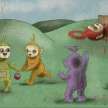Essay Structure Example
An essay about musics' impact on India. Pay attention to structure. I've used one of my students' papers to show you how structure is important.

I'm going to start this by saying that this structure isn't the best. Pay attention to my notes in Bold, as to why it isn't great.
How have music and performing arts played a role in nationalism and why are they important? In your answer, you must refer to India and Tibet. You may also refer to other parts of the world.
The given definition of nationalism is: ‘exalting one nation above all others and placing primary emphasis on promotion of its culture and interests as opposed to those of other nations’ When looking at nationalism in terms of music and arts, they are used to represent and emphasise particular aspects of the country in order to promote. Through emphasising particular ideas, it is then accepted into society and used to shape and change a society to embrace what is considered the music, or art of that country. Through this artistic propaganda, a government is able to define what they consider to be part of the country and what should be ostracised. One example, could be the how the courtesans of India were shunned for their practices, which eventually led to the devolution of the practice altogether.
Not only is the role of music and art important in nationalism, but it is also essential when looking at other aspects of nationalism or, patriotism: ‘love for or devotion to one's country.’ By understanding patriotism, what brings together the people of a nation the arts can be used a force of unification in a country. (This dosen't make sense) This is seen in Tibet, to incite feelings of patriotism is essential to the idea of identity politics.
However, when looking at the definition of modernisation, ‘the process of starting to use the most recent methods, ideas, equipment, etc. so that something becomes or seems more modern.’ It is essential to understand that modernisation can link with nationalism in that, music and the arts have had to adapt to a more modern setting in order to work. By keeping with traditional or older arts, it would not appeal to the whole nation, and so the evolution of the arts is necessary when looking at the role of music and art in nationalism. For example, when looking at popular film music of the time, that gives a strong element of nationalism, ‘Pardes’ is a film that discusses the theme of loving one’s country.
Also, the idea of identity links in, who do you belong to or identify with in the music or performance? (awkward sentence) Or indeed, identity in terms of what area of the country you are from, for Tibetans, they had their own music to reflect what Tibet was for them just as India does.
However, because of the number of states in India, it could be argued that someone maintain a distance with the idea of ‘Indian nationalism.’ For example, in the state of Punjab, the music videos and the lyrics do not talk about India as a whole, but only Punjab or the Punjabi culture with emphasis on the Sikh religion. So nationalism is not only important when presenting a country in general, but specific states with their own practices and possibly, religion. Similarly to Tibet, whose portrayal was different than that of China’s as they emphasised the state of Tibet for example, the description of the land and fields. Those these music are not necessarily protest songs, the ides of nationalism as political legitimacy is further provoked as Gellner stated: ‘Nationalism is primarily a political principle, which holds that the political and the national unit should be congruent.’ Where people can feel the same sentiment together such as pride, anger or love.
In a similar argument, patriotism is also an important aspect to consider when looking at the effects of the arts to nationalism, as they incite feelings of bringing the ‘nation’ together and what ideas they are trying to put forward about the country. Music and performing arts have changed the way countries portray themselves and how they are continued to be portrayed at the hands of the media through integration of western ideas and modernisation.
When looking at music as propaganda, one example that can be used is Tibet. With the reformation of culture under way in the 1950’s, the sudden change in the arts was seen as a way to obliterate the past and to give the arts a bigger role when presenting nationalism. In this case, portraying Tibet as a part of China. This is important when considering how much of the arts was censored because of their interpretations of Tibet – being an independent state to China. The response to the propaganda was negative and was portrayed as ‘un-modern’ which in turn leads to the idea of nationalism having to be modern.
The power of music and performing arts used by the government, do so in a way that they incite public attention: ‘by avoiding musical cliché, […] progressive music had the power to challenge cognitive, perceptual and emotional habits’.
When looking at the different types of Tibetan dancing in China, across some portrayals there are Western influences in the dance – such as ballet, when compared to traditional Tibetan dances performed by people, such as farmers. With government censorship, nationalism in this manner is seen as Tibetan dances performed in China ‘the right way,’ because of its’ modernity while clearing stating the difference between the more traditional form of Tibetan dancing. Censorship has the power to invent and ‘correct’ traditions in its’ ‘real’ manner through the manipulation of music and the performing arts. The manner in which certain songs were broadcasted, repeatedly, as Morcom states: ‘These revolutionary songs were taught in schools and political meetings, and loudspeakers and radios disseminated recorded versions across virtually every inch of the PRC.’ And by only portraying certain manners of performances of Tibetan dancing or translating songs from Chinese into Tibetan, then poses that although joint, China is more superior than Tibet. Not only in terms of geography or population, but in music and in the arts – implying the more refined way of dancing is superior than the old manner.
However, as censorship can limit what can be heard, it can also grab the attention of those who notice what songs are not being played anymore, which Morcom points out during the Cultural Revolution in Tibet: ‘revolutionary songs were played far less frequently and traditional music began to be broadcast on radio’.
But perhaps the limit of the effect music and performing arts is not just ‘nationalism’ in terms of country but in terms of the culture and people who follow the culture. DeNora notes: ‘As Shephard and Wicke have remarked, ‘a viable understanding of culture requires an understanding of its’ articulation through music just as much as a viable understanding of music requires an understanding of its’ place in culture.’ Music can be used in lots of manners because it is used to embody the social basis of a country as well as the political base. Even Hobsbawm describes:
…for if we regard ‘the nation’ as a very recent newcomer, and the product, and inevitably localised or regional, historical conjectures, we would expect it to occur, initially as it were, in a few colonies of settlement rather than in a population distributed over the world’s territory. But the problem is that there is no way of telling the observer how to distinguish a nation from other entities a piori.
In this case, music and performing arts can affect the people or group who enjoy the style or genre of music they listen to, regardless of identifying a specific ‘nation’ but rather, identifying the culture around those who listen to the music.
For example, when looking at concerts, the singer does not only sing, but he/she performs so the two become inextricably linked in the performance. Not only this, but the performance has a significant effect, whilst the lyrics are important, the performance itself is done for the pleasure of the audience so they can feel more involved. An example that can be used, is the Apocalyptica concert, in the video the band tells the audience to clap. This is an extremely important point when looking at the effect of music and arts in terms of power – the authority the performer wields in order to sway the audience and to manipulate their feelings because of what they perform and how they perform it.
Reformation of music and arts – modernisation and westernisation because of the zeitgeist of music and performing arts becoming outdated. Especially in Indian cinema, if one were to compare a film like Pakeezah from 1971, the song the protagonist dances to, is very different to way one of the character’s dances in Dabangg from 2011, as it is more provocative. The way the music and the lyrics portray the performers varies differently, for example in the clothes, the way they move, the lyrics etc. reflects the zeitgeist of two different periods.
Whilst there are some good points to this, it doesn't read well. Keep on topic when discussing an idea. A lot of the time, this changes from idea to idea, leading to it not always making sense. Chronology is everything - and this certainly doesn't read that way.
About the Creator
Rebecca Smith
She/Her
Just be f*cking nice 🙌






Comments
Rebecca Smith is not accepting comments at the moment
Want to show your support? Send them a one-off tip.